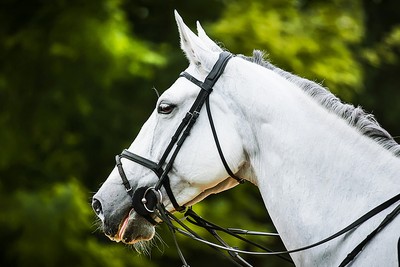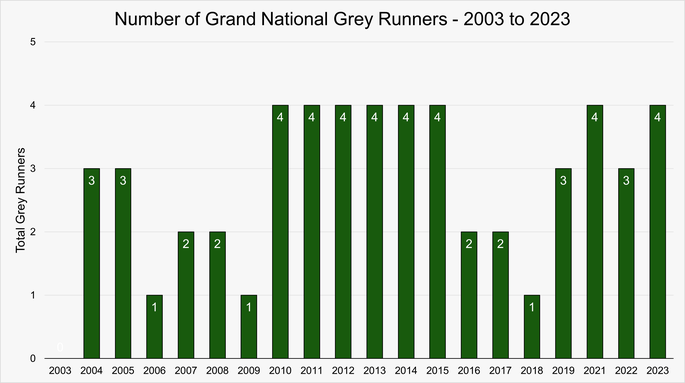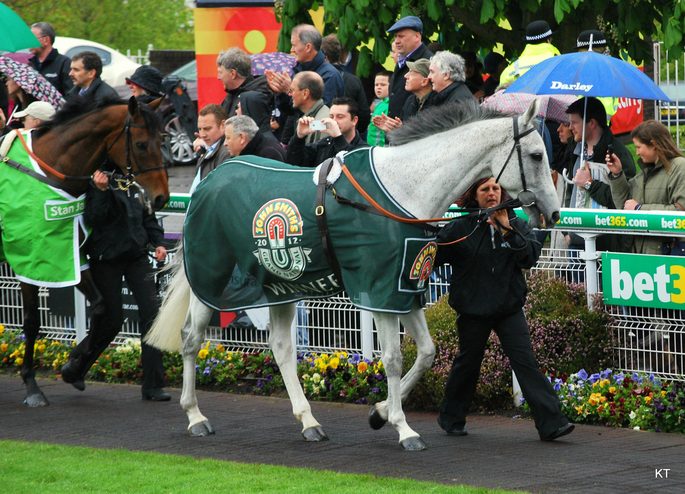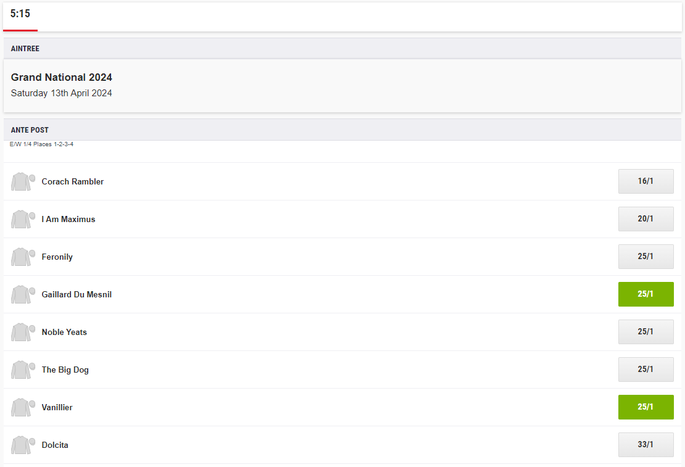 For bettors, there is something intriguing about placing a wager on a grey horse. Most punters tend to look for something that might make them lean towards a bet on one horse over another, with names being a key thing that the inexperienced bettor will look towards when picking out their horse for the Grand National. The colour that the horse rides in will also be a factor for some, especially if the jockey’s silks happen to be in their favourite colour. Grey horses stand out in a crowd, so they will often be something that people look towards when choosing what to bet on.
For bettors, there is something intriguing about placing a wager on a grey horse. Most punters tend to look for something that might make them lean towards a bet on one horse over another, with names being a key thing that the inexperienced bettor will look towards when picking out their horse for the Grand National. The colour that the horse rides in will also be a factor for some, especially if the jockey’s silks happen to be in their favourite colour. Grey horses stand out in a crowd, so they will often be something that people look towards when choosing what to bet on.
For others, they will actively choose not to bet on a grey horse. Almost everyone knows that there have only been four grey winners of the Grand National over the years, with two of those being the same horse. In other words, only three greys have won the National since it first began in 1839. The stats, then, appear to suggest that a bet on a grey horse is more likely to be a losing bet than not. The problem is, not many people have looked at how many greys have actually started the ‘World’s Greatest Steeplechase’, so we don’t know whether four winners is good or bad.
Quick Answer: How Many Grey Horses Have Won the Grand National?
Since the first Grand National in 1839 the race has been won by a grey horse on four occasions by three different horses. The Lamb in 1868 and 1871, Nicolaus Silver in 1961 and Neptune Collonges in 2012.
Historically, grey horses have won just 2.2% of the Grand Nationals run, with roughly one grey winner every 45.5 years.
Looking At 20 Years’ Worth Of Data
The Grand National is one of the world’s most loved horse races, with hundreds of millions of people around the world tuning in to watch it play out every April. As a result, there tends to be quite a lot of data about the race that we are able to look towards to get a sense of trends and statistics. When it comes to grey horses, that dates back about 20 years, before which point things tend to become a little bit trickier to find out. With that in mind, here is the data that we’ve been able to mine around grey horses running in the Grand National between 2003 and 2023:

In total, there were 795 runners across the 20 years that we’re looking at. Of those, 55 were grey horses.
That means that 6.9% of all of the runners that took part in the Grand National across the 20 years in question were grey horses.
Over the 20 races that we’re looking at, there has been one grey winner. That means that greys win on 5% of occasions, of the snapshot that we’re looking at is accurate.
Fine Margins
Thanks to the records that have been kept of the Grand National over the years, we know that a grey horse has won the ‘World’s Greatest Steeplechase’ on four occasions. Across 182 races, that works out as 2.2% of the time. The problem is, we don’t know how many grey horses there were in total during the early years of the Aintree race. We do have that information for the more recent renewals of the race and we know that grey horses have won 5% of the time. The difference between 2.2% and 5% isn’t radical enough to mean that it is a huge departure from what we know.
That being said, we know that the percentage of the total horses that have been grey during our 20 year period is 6.9%. It wouldn’t be unreasonable to expect 6.9% of the winners of the National to have been grey, but the figure is 5%. The problem is, there are really small margins that we’re dealing with here. Had another grey horse won during our period of time in question, it would mean that 10% of the winners had been grey. It means that it seems to fit in with what we know, but it is difficult to make sweeping assumptions about the race overall because of the paucity of data in the early years.
The Winning Greys

By Carine06, flickr
At the time of writing, just three grey horses have won the Grand National since the race first began. It is worth having a quick look at them to see what we actually know:
The Lamb
| Year | Age | Odds | Weight | Jockey | Trainer |
|---|---|---|---|---|---|
| 1868 | 6 | 9/1 | 11-7 | Geroge Ede | Ben Land |
| 1871 | 9 | 11/2 | 11-5 | Tommy Pickernell | Chris Green |
The most successful grey in the history of the Grand National is a horse called The Lamb. He won it for the first time in 1868, ridden by Mr George Eden and trained Ben Land for owner Lord Poulett. Carrying a weight of 10 stone 7 pounds, the horse reportedly had a small frame and a pleasant demeanour, which was reflected in the horse’s name. When he won the race for the first time he was just six-years-old, which is young for a horse in the modern era. In fact, the last horse to win at such a young age was Ally Sloper in 1915, with none doing so since.
In the two years that followed, the ‘World’s Greatest Steeplechase’ was won by The Colonel. It meant that The Lamb had to fight back to reclaim his prize in 1871, at which point he was a much more understandable age of nine. He was still owned by Lord Poulett, but Chris Green had taken over as trainer and Mr Tommy Pickernell was in the saddle. He ran with 11 stone and 5 pounds, coming home with odds of 11/2, as opposed to the 9/1 odds he’d been given three years earlier. Finishing with a time of nine minutes and 35.7 seconds, he is the only grey to have won the race twice.
Interestingly, there are paintings of the winner of the 1871 Grand National that depict the winning horse as being black. This adds some controversy to the notion of a grey horse winning the event twice. It is obviously possible that he simply matured, but that isn’t really the way colours work in horses. More likely is the idea that the artist simply didn’t want to paint a grey horse and so made him black in the painting. Regardless, The Lamb is thought of as being the only grey to have won the Grand National twice and we’re not going to argue with that.
Nicolaus Silver
| Year | Age | Odds | Weight | Jockey | Trainer |
|---|---|---|---|---|---|
| 1961 | 9 | 28/1 | 10-1 | Bobby Beasley | Fred Rimell |
That it took nearly 100 years for another grey horse to win the Grand National probably tells you quite a lot about the horses and the Aintree race. Bred by James Heffernan in Tipperary, Ireland, he was out of another grey named Rays of Montrose by Nicolaus. Dan Kirwan had been training him, but when he died suddenly in 1960 the horse was sold at the Dublin Ballsbridge sales in November of that year. Charles Vaughan paid £2,600 for him, knowing that he’d already qualified for the Grand National, which he started with odds of 28/1 and Bobby Beasley on his back.
From early on in the second circuit of the Aintree course Nicolaus Silver was one of the front runners. He drew clear of the chasing back at the penultimate fence and eventually won by five lengths. It was a second win for the trainer Fred Rimell, who had also won the race in 1956 thanks to ESB. Nicolaus Silver had been the target of dopers prior to the race but managed to avoid any repercussions, becoming just the second grey to have won the event. Interestingly, he nearly repeated The Lamb’s achievement when he came second the year after.
Neptune Collonges
| Year | Age | Odds | Weight | Jockey | Trainer |
|---|---|---|---|---|---|
| 2012 | 11 | 33/1 | 11-6 | Daryl Jacob | Paul Nicholls |
The most recent grey winner of the race at the time of writing is Neptune Collonges. Having started racing as a three-year-old, the French horse’s first win of any note came when he was the winner of the Winter Novices’ Hurdle at Sandown Park Racecourse in 2005. He picked up and injury in the Gold Cup in 2009, putting him out of action for the rest of the season and all of the following one, having won 14 races to that point. Many feared that his best days might be behind him, but he won the Argento Chase at Cheltenham Festival Trials Day in 2011 to prove there was still some life left in him.
When he was entered into the Grand National in 2012, he did so with odds of 33/1. Trained by Paul Nicholls for owner John Hales, Daryl Jacob was given the honour of riding him. It was a thrilling race, with Neptune Collonges and Sunnyhillboy battling it out. In the end, the grey won by a nose, which was the closest ever finish the race. He became just the third grey horse to taste success in the event, as well as being just the fourth time that the National had been won by a grey. He was retired immediately after the race, retainined for dressage events instead.
What It Means For Bettors

The question that you might be asking yourself is what, exactly, that all means from a punter’s point of view. The answer is that bets on greys aren’t entirely pointless, but they are less likely to win the event than non-greys depending on how many of them are taking part in a race. The maximum number of greys that have run in the National over the 20 years that we’re looking at is four, which amounted for 10% of the total runners. As things currently stand, they have won the event 5% of the time, which is about right considering 6.9% of all runners have been grey.
Of course, the further we get away from 2012 without a grey winner, the more likely it is that we’ll get one in order to even out the percentages. We are discounting the earlier years of the event because we just don’t have the stats to tell us what it all means, but the longer we go without a grey winner the more likely it is that there’ll be a grey due to the way that the stats work. If you watch the race in 2043 and there hasn’t been a grey in the years since, it might be worth considering placing a bet on one as the likelihood is that there will be a winner sooner rather than later.
